Immersive 3D Soundscape: Analysis of Environmental Acoustic Parameters of Historical Squares in Parma (Italy)
Abstract
1. Introduction
2. Italian Squares and Sonic Captures
3. Materials and Methods
3.1. Selected Soundscapes Across the City of Parma
3.1.1. Piazza Garibaldi in Parma
3.1.2. Piazza Duomo in Parma
3.1.3. Piazzale Della Pilotta
3.2. Acoustic Measurements
3.3. Digital Audio-Video Processing
4. Analysis of Measured Results
4.1. Environmental Acoustic Parameters
4.2. Three-Dimensional Acoustic Maps for a More Comprehensive Soundscape
5. Audio-Video Reproduction
6. Discussion
7. Conclusions
Author Contributions
Funding
Data Availability Statement
Acknowledgments
Conflicts of Interest
References
- Hao, Y.; Kang, J.; Krijnders, J.D. Integrated effects of urban morphology on birdsong loudness and visibility of green areas. Landsc. Urban Plan. 2015, 137, 149–162. [Google Scholar] [CrossRef]
- Cardoso, G.C.; Atwell, J.W. On the relation between loudness and the increased song frequency of urban birds. Anim. Behav. 2011, 82, 831–836. [Google Scholar] [CrossRef] [PubMed]
- Francis, C.D.; Ortega, C.P.; Cruz, A. Noise Pollution Changes Avian Communities and Species Interactions. Curr. Biol. 2009, 19, 1415–1419. [Google Scholar] [CrossRef] [PubMed]
- Wrege, P.H.; Rowland, E.D.; Keen, S. Acoustic monitoring for conservation in tropical forests: Examples from forest elephants. Methods Ecol. Evol. 2017, 8, 1292–1301. [Google Scholar] [CrossRef]
- ISO/TS 12913; Acoustics—Soundscape. Part 3: Data Analysis. International Standards Organization: Geneva, Switzerland, 2019.
- Watcharasupat, K.N.; Jaratjarungkiat, S.; Lam, B.; Jitwiriyanont, S.; Ooi, K.; Ong, Z.T.; Pichetpan, N.; Akaratham, K.; Suthiwan, T.; Rojtinnakorn, M.; et al. Quantitative evaluation approach for translation of perceptual soundscape attributes: Initial application to the Thai Language. Appl. Acoust. 2022, 200, 108962. [Google Scholar] [CrossRef]
- Jeon, J.Y.; Hong, J.Y.; Lavandier, C.; Lafon, J.; Axelsson, Ö.; Hurtig, M. A cross-national comparison in assessment of urban park soundscapes in France, Korea, and Sweden through laboratory experiments. Appl. Acoust. 2018, 133, 107–117. [Google Scholar] [CrossRef]
- Jeon, J.Y.; Jo, H.I. Effects of audio-visual interactions on soundscape and landscape perception and their influence on satisfaction with the urban environment. Build. Environ. 2020, 169, 106544. [Google Scholar] [CrossRef]
- Lellouch, L.; Haupert, S.; Sueur, J. Sound source localization in a natural soundscape with autonomous recorder units based on a new time-difference-of-arrival algorithm. Appl. Acoust. 2025, 235, 110648. [Google Scholar] [CrossRef]
- Abadi, S.H.; Wacker, D.W.; Newton, J.G.; Flett, D. Acoustic localization of crows in pre-roost aggregations. J. Acoust. Soc. Am. 2019, 146, 4664–4671. [Google Scholar] [CrossRef]
- Rhinehart, T.A.; Chronister, L.M.; Devlin, T.; Kitzes, J. Acoustic localization of terrestrial wildlife: Current practicesand future opportunities. Ecol. Evol. 2020, 10, 6794–6818. [Google Scholar] [CrossRef]
- Calupca, T.A.; Fristrup, K.M.; Clark, C.W. A compact digital re-cording system for autonomous bioacoustic monitoring. J. Acoust. Soc. Am. 2020, 108, 2582. [Google Scholar] [CrossRef]
- Benz, S.; Kuhlmann, J.; Jeram, S.; Bartels, S.; Ohlenforst, B.; Schreckenberg, D. Impact of Aircraft Noise on Health. Impact of Aircraft Noise on Health. In Aviation Noise Impact Management; Leylekian, L., Covrig, A., Maximova, A., Eds.; Springer: Cham, Switzerland, 2022. [Google Scholar] [CrossRef]
- Nature’s Soundtrack Reveals the Secrets of Degradation. Available online: https://www.wired.com/story/nature-digital-listening-environment/?utm_source=chatgpt.com (accessed on 4 June 2025).
- Stowell, D.; Sueur, J. Ecoacoustics: Acoustic sensing for biodiversity monitoring at scale. Remote Sens. Ecol. Conserv. 2020, 6, 217–219. [Google Scholar] [CrossRef]
- Xu, Z.; Georgiadis, T.; Cremonini, L.; Marini, S.; Toselli, S. The Perceptions and Attitudes of Residents Towards Urban Green Spaces in Emilia-Romagna (Italy)—A Case Study. Land 2025, 14, 13. [Google Scholar] [CrossRef]
- Barbi, V.; Ginocchini, G.; Sponza, C. Co-Designing the Accessibility: From Participatory Mapping to New Inclusive Itineraries Through the Cultural Heritage of Bologna. Eur. J. Creat. Pract. Cities Landsc. 2020, 3, 127–146. [Google Scholar] [CrossRef]
- Migrant Integration Hub. Available online: https://migrant-integration.ec.europa.eu/integration-practice/regional-centre-against-discrimination-region-emilia-romagna_de?utm_source=chatgpt.com (accessed on 9 May 2025).
- Bevilacqua, A.; Merli, F.; Armelloni, E.; Farina, A.; Farina, A.; Tronchin, L. Acoustic parameters of the Municipal theatre of Piacenza shown on different ways of representation. In Proceedings of the 2021 Immersive 3D Audio: From Architecture to Automotive, Bologna, Italy, 8–10 September 2021. [Google Scholar] [CrossRef]
- Rocchi, N.; Toscani, A.; Pinardi, D.; Bonomi, E.; Tronchin, L. A modular, low latency, A2B-based architecture for distributed multichannel full-digital audio systems. In Proceedings of the 2021 Immersive 3D Audio: From Architecture to Automotive, Bologna, Italy, 8–10 September 2021. [Google Scholar]
- Dines, N. The politics of the piazza: The history and meaning of the Italian square, by Eamonn Canniffe. In Modern Italy; Cambridge University Press: Cambridge, UK, 2010; Volume 15, pp. 115–118, (In Italian). [Google Scholar] [CrossRef]
- Isnenghi, M. L’Italia in Piazza, 2nd ed.; il Mulino: Bologna, Italy, 2004. (In Italian) [Google Scholar]
- Barbiani, L. La Piazza Storica Italiana. Analisi di un Sistema Complesso; Marsilio: Venice, Italy, 1992. (In Italian) [Google Scholar]
- Tronchin, L.; Bevilacqua, A.; Yan, R.; Van Tonder, C. Explore the acoustics of Teatro dell’Opera of Rome. In Proceedings of the 2023 Immersive 3D Audio: From Architecture to Automotive, Bologna, Italy, 7–9 September 2023. [Google Scholar]
- Merli, F.; Bevilacqua, A. Using a Church as a Temporary Auditorium. Acoustical Design of S. Domenico of Imola. J. Phys. Conf. Ser. 2020, 1655, 012146. [Google Scholar] [CrossRef]
- Banzola, V.; Calvani, M.M. Parma: La Citta Storica; Cassa di Risparmio di Parma: Parma, Italy, 1978. (In Italian) [Google Scholar]
- Vera, D. Storia di Parma: Vol. II: Parma Romana; Monte Università Parma Editore: Parma, Italy, 2009. (In Italian) [Google Scholar]
- Adorni, E. The steeple spire of the Parma Cathedral: An analysis of the glazed bricks and mortars. J. Eur. Ceram. Soc. 2013, 33, 2801–2809. [Google Scholar] [CrossRef]
- Potenza, M.; Bergamonti, L.; Graiff, C.; Bersani, D.; Fornasini, L.; Simeti, S.; Casoli, A. Mural Painting Discovered in the Crypt of the Cathedral of Parma (Italy): Multi-Technique Investigations for the Conservative Restoration Project. Heritage 2025, 8, 87. [Google Scholar] [CrossRef]
- Schianchi, L.F. The Palazzo della Pilotta in Parma: From Court Services to Modern Cultural Institutions; Franco Maria Ricci Ed.: Parma, Italy, 1996. (In Italian) [Google Scholar]
- mhAcoustics. Available online: https://mhacoustics.com/products (accessed on 9 May 2025).
- Kandao Qoocam 3 Ultra 8k. Available online: https://www.kandaovr.com/qoocam-3-ultra (accessed on 9 May 2025).
- Tronchin, L. Variability of room acoustic parameters with thermo-hygrometric Conditions. Appl. Acoust. 2021, 177, 107933. [Google Scholar] [CrossRef]
- Plogue Bidule. Available online: https://www.plogue.com/products/bidule.html (accessed on 9 May 2025).
- Jekateryńczuk, G.; Piotrowski, Z. A Survey of Sound Source Localization and Detection Methods and Their Applications. Sensors 2023, 24, 68. [Google Scholar] [CrossRef] [PubMed] [PubMed Central]
- Daniel, J.; Moreau, S. Further Study of Sound Field Coding with Higher Order Ambisonics. In Proceedings of the 116th Convention Audio Engineering Society (AES), Berlin, Germany, 8–11 May 2004. [Google Scholar]
- Revita, R.; Mukmin, B.A.; Mujiwati, E.S. Development of learning videos based on Adobe Premiere Pro for elementary school students. J. Edusci. 2024, 11, 83–92. [Google Scholar] [CrossRef]
- ISO 532-1:2017(E); Acoustics—Methods for Calculating Loudness—Part 1: Zwicker Method. International Organization for Standardization: Geneva, Switzerland, 2017.
- Zwicker, E.; Hugo, F. Psychoacoustics: Facts and Models; Springer Science & Business Media: Berlin/Heidelberg, Germany, 2013; Volume 22. [Google Scholar]
- ECMA-418-1; Psychoacoustic Metrics for ITT Equipment—Part 1 (Prominent Discrete Tones). Ecma International: Geneva, Switzerland, 2020. Available online: https://ecma-international.org/publications-and-standards/standards/ecma-418/ (accessed on 3 January 2025).
- Yao, D.; Xu, H.; Li, J.; Xia, R.; Yan, Y. Binaural rendering technology over loudspeakers and headphones. Acoust. Sci. Technol. 2020, 41, 134–141. [Google Scholar] [CrossRef]
- Fırat, H.B. Acoustics as Tangible Heritage: Re-embodying the Sensory Heritage in the Boundless Reign of Sight. Preserv. Digit. Technol. Cult. 2021, 50, 3–14. [Google Scholar] [CrossRef]
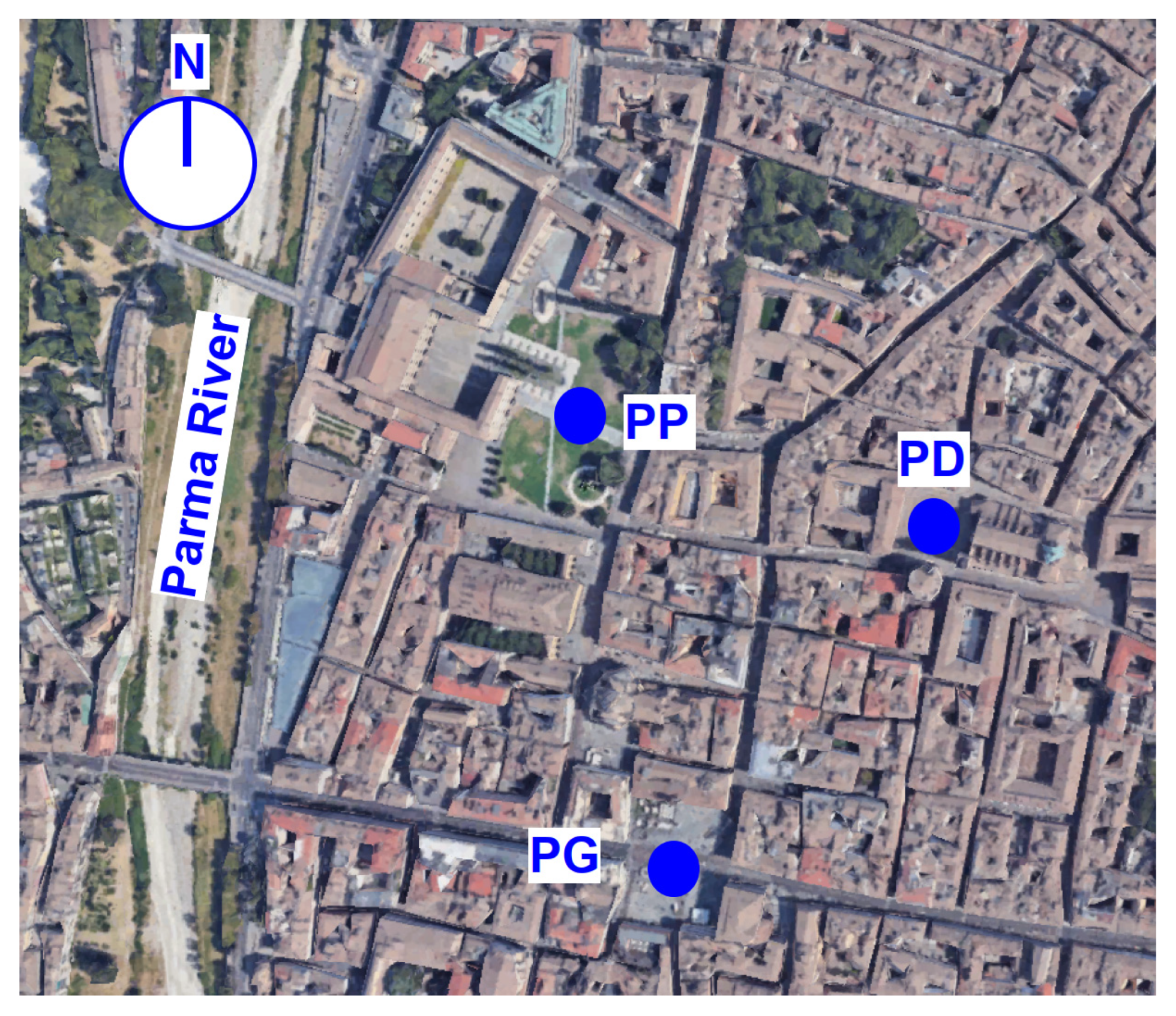
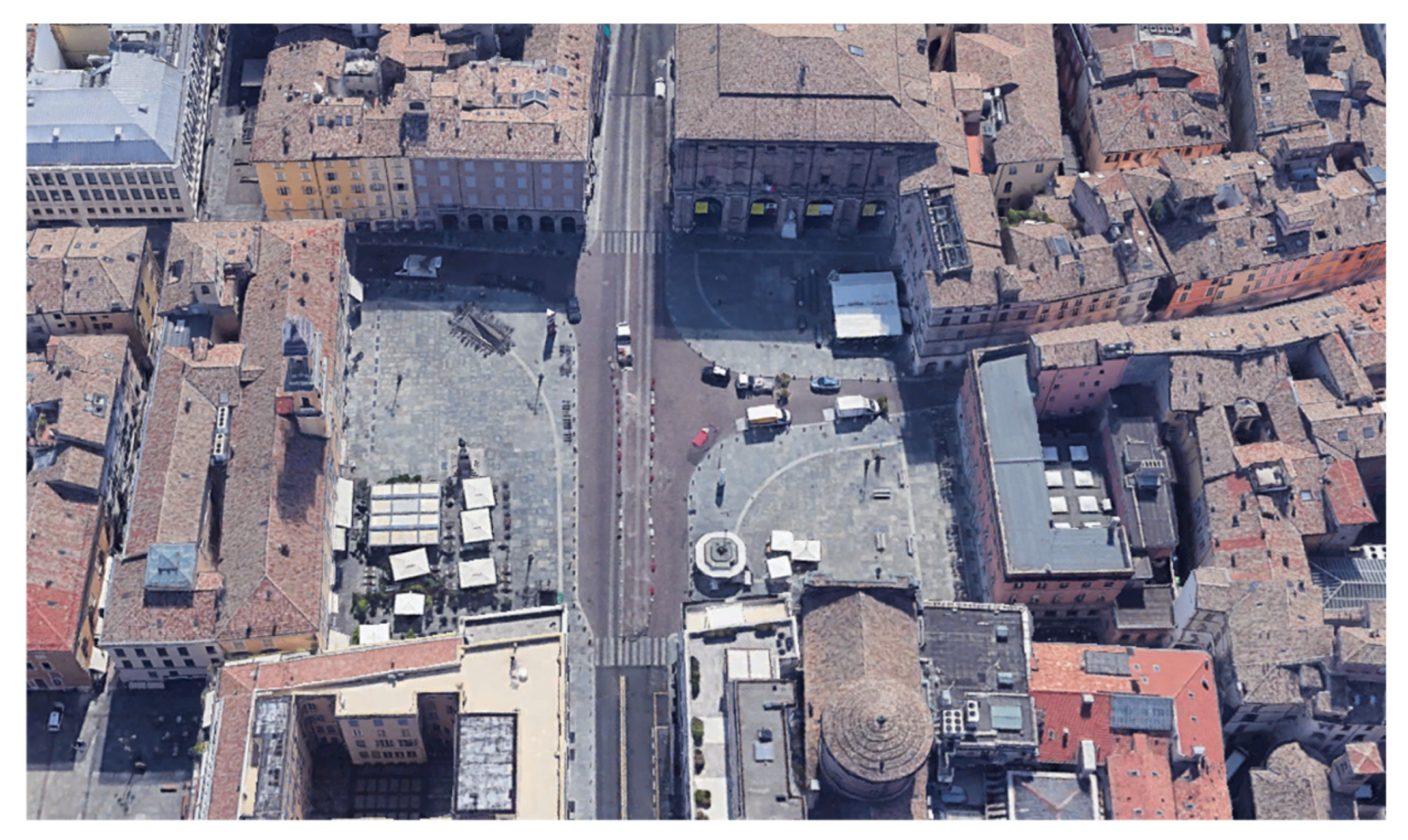
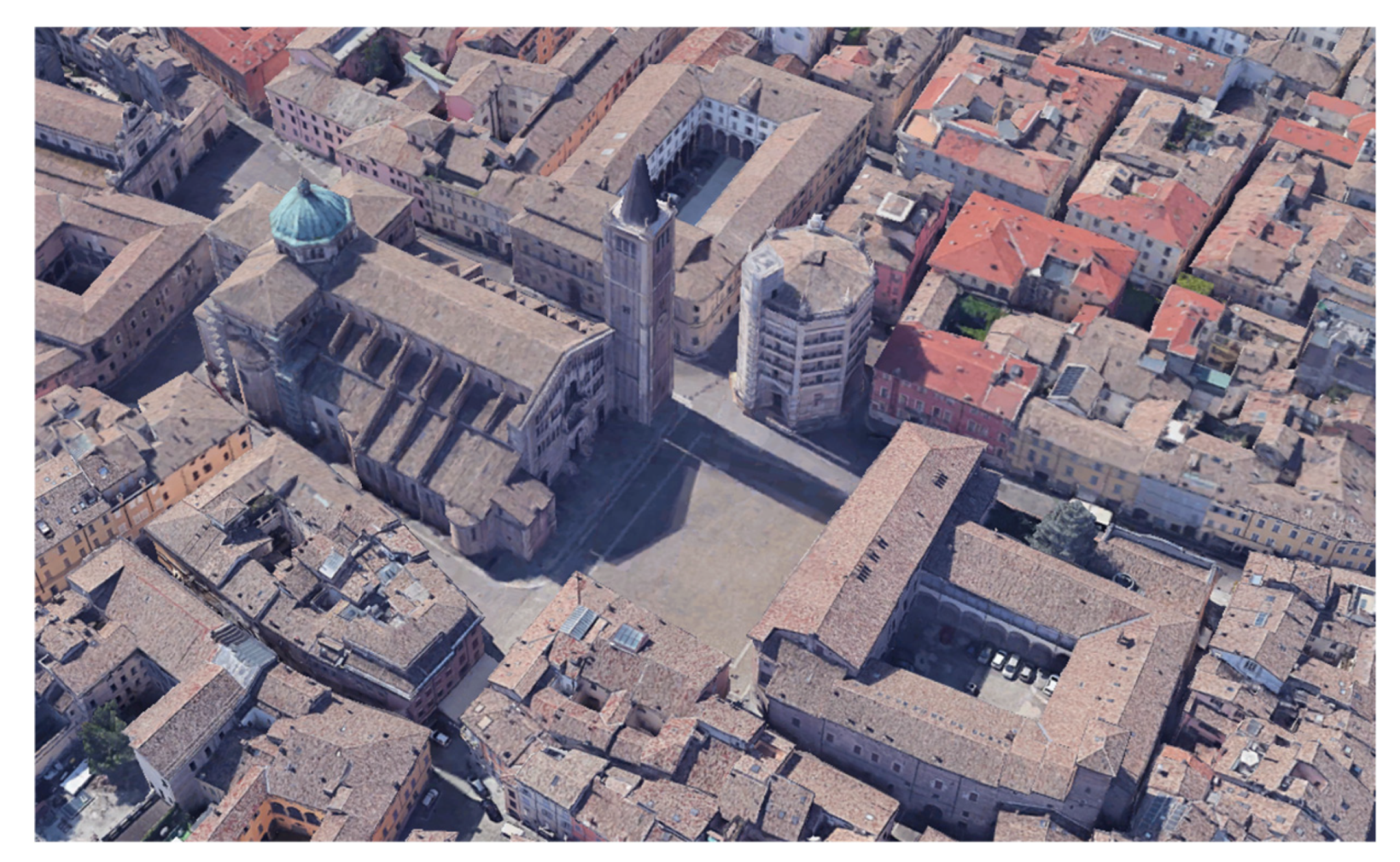

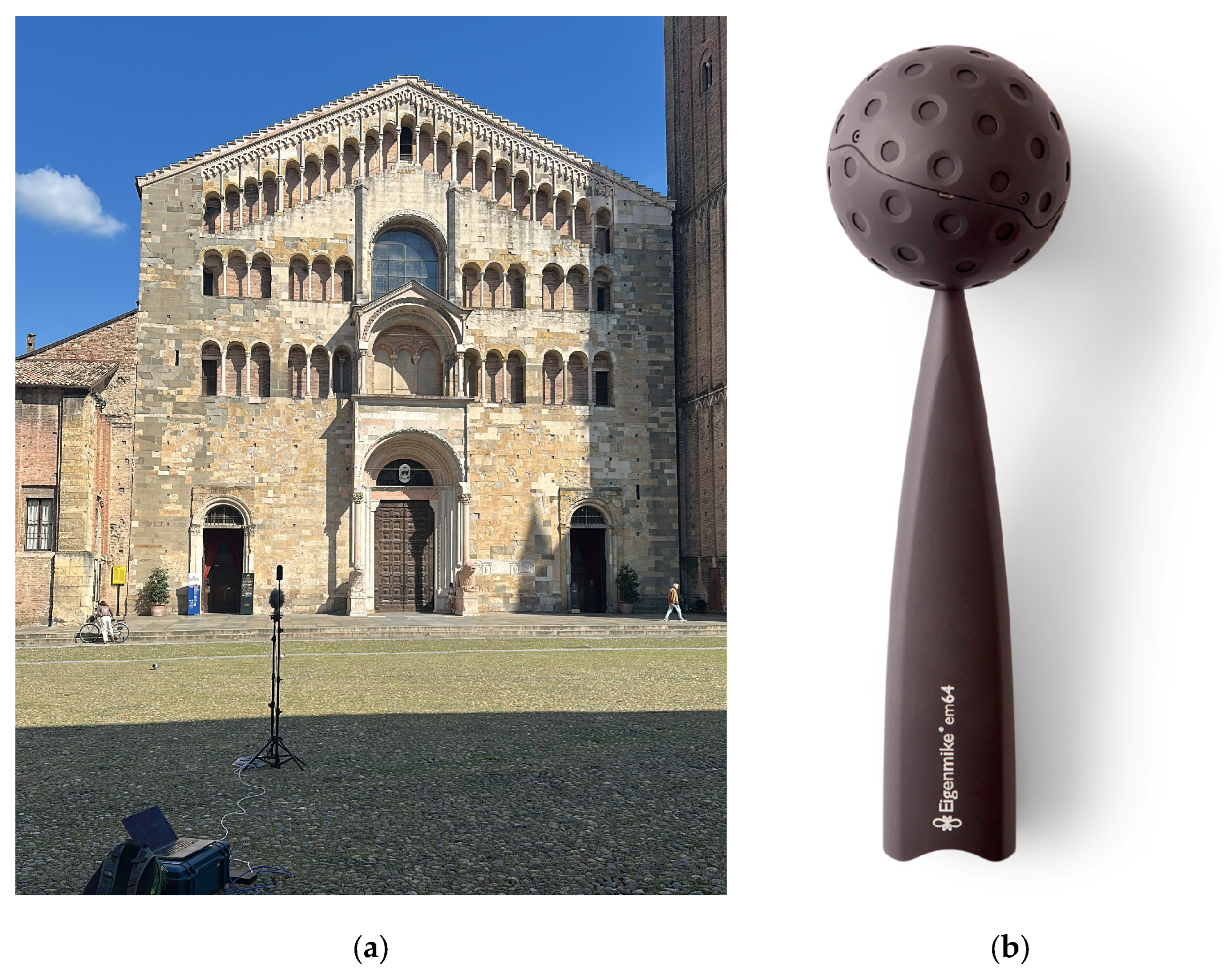
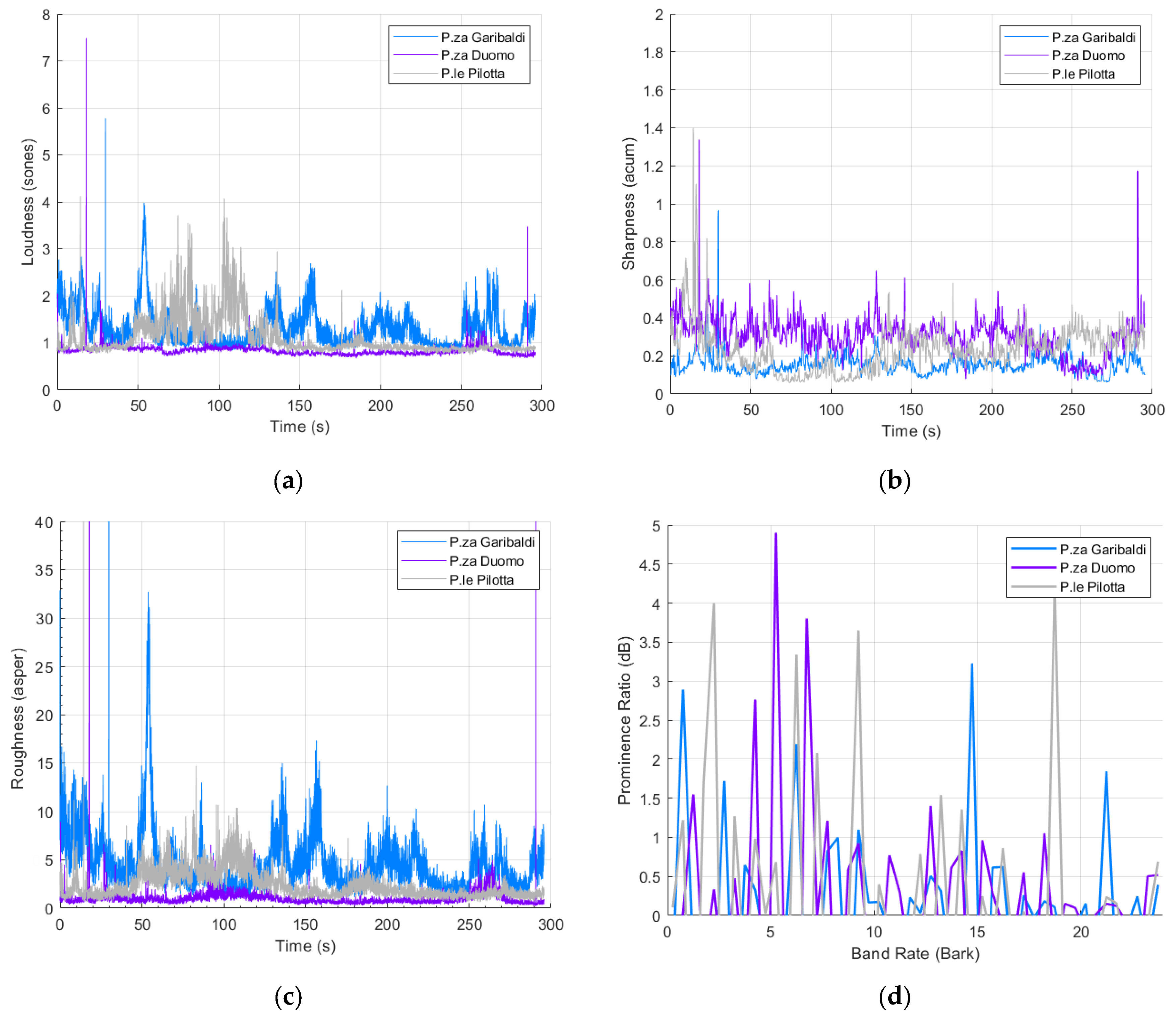
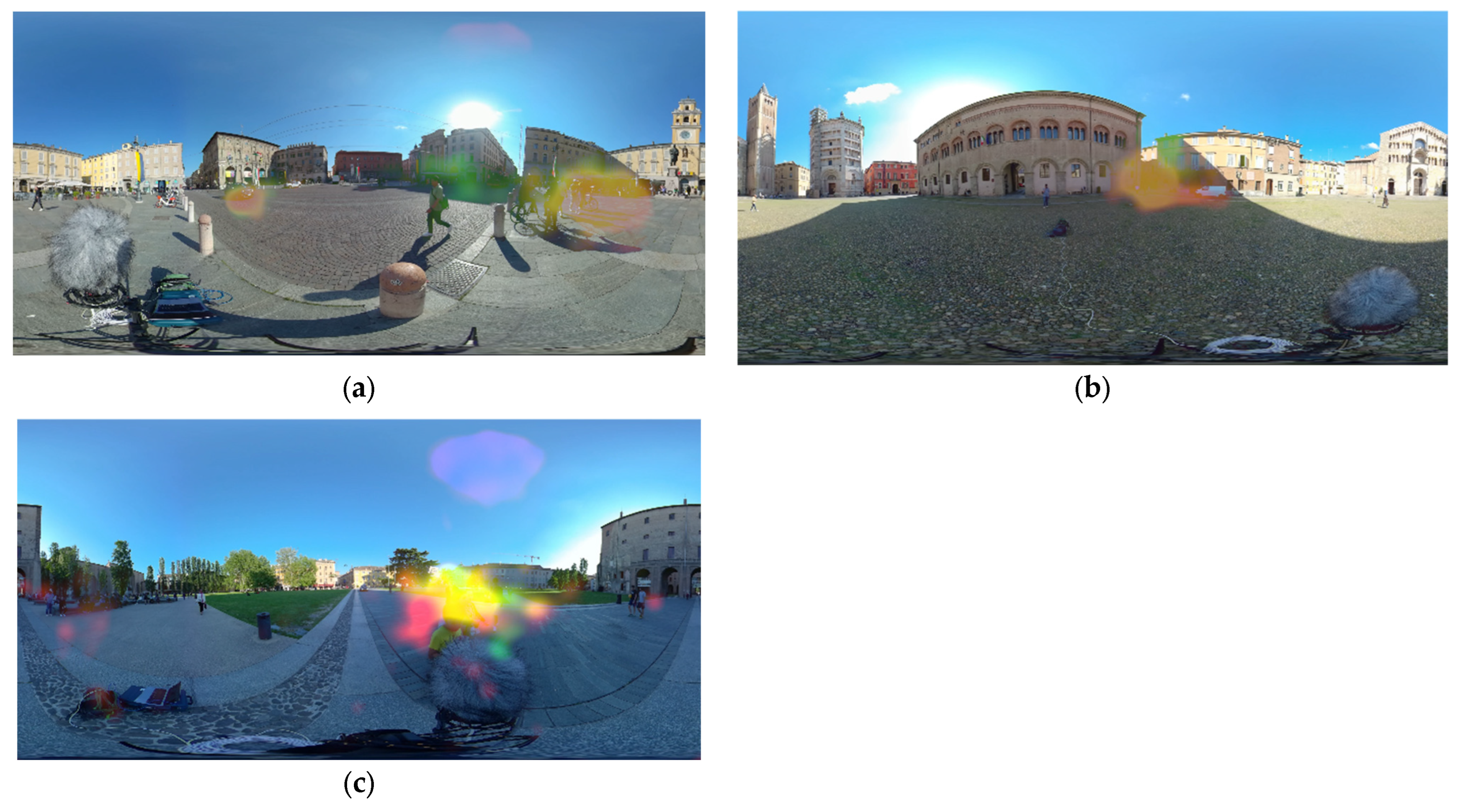
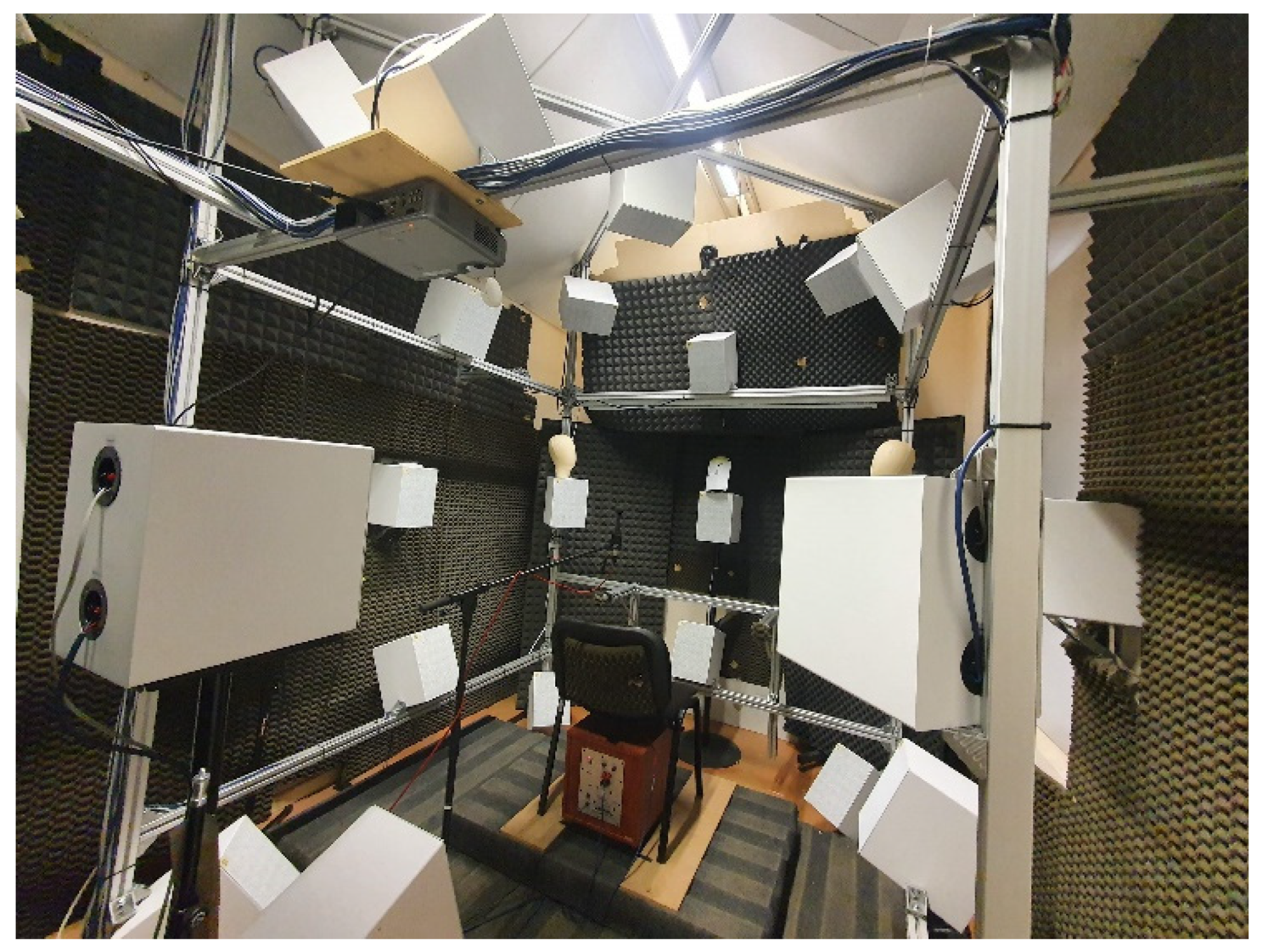
| Location | Mean Loudness (Sones) | Mean Sharpness (Acum) | Mean Roughness (Asper) | Mean Prominence (dB) |
|---|---|---|---|---|
| Piazza Garibaldi | 1.3 | 0.2 | 4.7 | 1.1 |
| Piazza Duomo | 0.9 | 0.4 | 1.3 | 1.4 |
| Piazzale della Pilotta | 1.2 | 0.3 | 3.2 | 0.9 |
Disclaimer/Publisher’s Note: The statements, opinions and data contained in all publications are solely those of the individual author(s) and contributor(s) and not of MDPI and/or the editor(s). MDPI and/or the editor(s) disclaim responsibility for any injury to people or property resulting from any ideas, methods, instructions or products referred to in the content. |
© 2025 by the authors. Licensee MDPI, Basel, Switzerland. This article is an open access article distributed under the terms and conditions of the Creative Commons Attribution (CC BY) license (https://creativecommons.org/licenses/by/4.0/).
Share and Cite
Farina, A.; Bevilacqua, A.; Fadda, M.; Battisti, L.; Tommasino, M.C.; Tronchin, L. Immersive 3D Soundscape: Analysis of Environmental Acoustic Parameters of Historical Squares in Parma (Italy). Urban Sci. 2025, 9, 259. https://doi.org/10.3390/urbansci9070259
Farina A, Bevilacqua A, Fadda M, Battisti L, Tommasino MC, Tronchin L. Immersive 3D Soundscape: Analysis of Environmental Acoustic Parameters of Historical Squares in Parma (Italy). Urban Science. 2025; 9(7):259. https://doi.org/10.3390/urbansci9070259
Chicago/Turabian StyleFarina, Adriano, Antonella Bevilacqua, Matteo Fadda, Luca Battisti, Maria Cristina Tommasino, and Lamberto Tronchin. 2025. "Immersive 3D Soundscape: Analysis of Environmental Acoustic Parameters of Historical Squares in Parma (Italy)" Urban Science 9, no. 7: 259. https://doi.org/10.3390/urbansci9070259
APA StyleFarina, A., Bevilacqua, A., Fadda, M., Battisti, L., Tommasino, M. C., & Tronchin, L. (2025). Immersive 3D Soundscape: Analysis of Environmental Acoustic Parameters of Historical Squares in Parma (Italy). Urban Science, 9(7), 259. https://doi.org/10.3390/urbansci9070259








